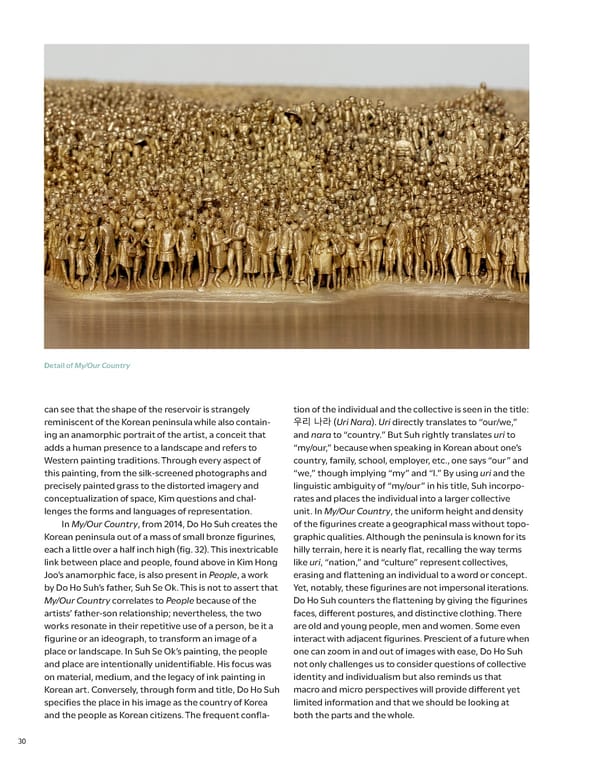Detail of My/Our Country can see that the shape of the reservoir is strangely tion of the individual and the collective is seen in the title: reminiscent of the Korean peninsula while also contain- 우리 나라 (Uri Nara). Uri directly translates to “our/we,” ing an anamorphic portrait of the artist, a conceit that and nara to “country.” But Suh rightly translates uri to adds a human presence to a landscape and refers to “my/our,” because when speaking in Korean about one’s Western painting traditions. Through every aspect of country, family, school, employer, etc., one says “our” and this painting, from the silk- screened photographs and “we,” though implying “my” and “I.” By using uri and the precisely painted grass to the distorted imagery and linguistic ambiguity of “my/our” in his title, Suh incorpo- conceptualization of space, Kim questions and chal- rates and places the individual into a larger collective lenges the forms and languages of representation. unit. In My/Our Country, the uniform height and density In My/Our Country, from 2014, Do Ho Suh creates the of the 昀椀gurines create a geographical mass without topo- Korean peninsula out of a mass of small bronze 昀椀gurines, graphic qualities. Although the peninsula is known for its each a little over a half inch high (昀椀g. 32). This inextricable hilly terrain, here it is nearly 昀氀at, recalling the way terms link between place and people, found above in Kim Hong like uri, “nation,” and “culture” represent collectives, Joo’s anamorphic face, is also present in People, a work erasing and 昀氀attening an individual to a word or concept. by Do Ho Suh’s father, Suh Se Ok. This is not to assert that Yet, notably, these 昀椀gurines are not impersonal iterations. My/Our Country correlates to People because of the Do Ho Suh counters the 昀氀attening by giving the 昀椀gurines artists’ father- son relationship; nevertheless, the two faces, di昀昀erent postures, and distinctive clothing. There works resonate in their repetitive use of a person, be it a are old and young people, men and women. Some even 昀椀gurine or an ideograph, to transform an image of a interact with adjacent 昀椀gurines. Prescient of a future when place or landscape. In Suh Se Ok’s painting, the people one can zoom in and out of images with ease, Do Ho Suh and place are intentionally unidenti昀椀able. His focus was not only challenges us to consider questions of collective on material, medium, and the legacy of ink painting in identity and individualism but also reminds us that Korean art. Conversely, through form and title, Do Ho Suh macro and micro perspectives will provide di昀昀erent yet speci昀椀es the place in his image as the country of Korea limited information and that we should be looking at and the people as Korean citizens. The frequent con昀氀a- both the parts and the whole. 30
 Lineages | Korean Art at The Met Page 31 Page 33
Lineages | Korean Art at The Met Page 31 Page 33